OBD port JAGUAR XFR 2010 1.G Workshop Manual
[x] Cancel search | Manufacturer: JAGUAR, Model Year: 2010, Model line: XFR, Model: JAGUAR XFR 2010 1.GPages: 3039, PDF Size: 58.49 MB
Page 53 of 3039
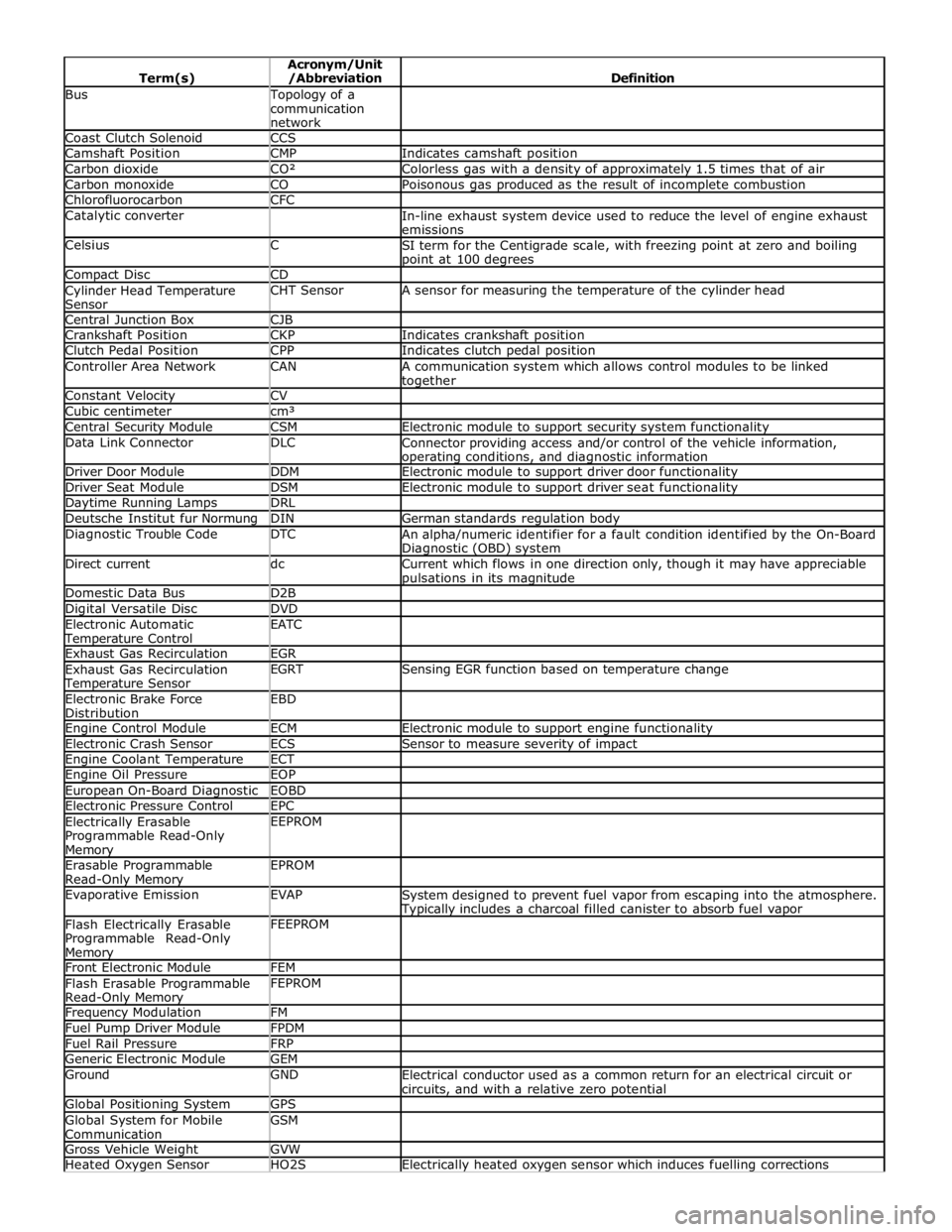
Bus Topology of a
communication
network Coast Clutch Solenoid CCS Camshaft Position CMP Indicates camshaft position Carbon dioxide CO² Colorless gas with a density of approximately 1.5 times that of air Carbon monoxide CO Poisonous gas produced as the result of incomplete combustion Chlorofluorocarbon CFC Catalytic converter
In-line exhaust system device used to reduce the level of engine exhaust
emissions Celsius C
SI term for the Centigrade scale, with freezing point at zero and boiling point at 100 degrees Compact Disc CD Cylinder Head Temperature
Sensor CHT Sensor A sensor for measuring the temperature of the cylinder head Central Junction Box CJB Crankshaft Position CKP Indicates crankshaft position Clutch Pedal Position CPP Indicates clutch pedal position Controller Area Network CAN
A communication system which allows control modules to be linked together Constant Velocity CV Cubic centimeter cm³ Central Security Module CSM Electronic module to support security system functionality Data Link Connector DLC
Connector providing access and/or control of the vehicle information, operating conditions, and diagnostic information Driver Door Module DDM Electronic module to support driver door functionality Driver Seat Module DSM Electronic module to support driver seat functionality Daytime Running Lamps DRL Deutsche Institut fur Normung DIN German standards regulation body Diagnostic Trouble Code DTC
An alpha/numeric identifier for a fault condition identified by the On-Board Diagnostic (OBD) system Direct current dc
Current which flows in one direction only, though it may have appreciable pulsations in its magnitude Domestic Data Bus D2B Digital Versatile Disc DVD Electronic Automatic Temperature Control EATC
Exhaust Gas Recirculation EGR Exhaust Gas Recirculation Temperature Sensor EGRT Sensing EGR function based on temperature change Electronic Brake Force
Distribution EBD
Engine Control Module ECM Electronic module to support engine functionality Electronic Crash Sensor ECS Sensor to measure severity of impact Engine Coolant Temperature ECT Engine Oil Pressure EOP European On-Board Diagnostic EOBD Electronic Pressure Control EPC Electrically Erasable
Programmable Read-Only Memory EEPROM
Erasable Programmable
Read-Only Memory EPROM
Evaporative Emission EVAP
System designed to prevent fuel vapor from escaping into the atmosphere. Typically includes a charcoal filled canister to absorb fuel vapor Flash Electrically Erasable
Programmable Read-Only Memory FEEPROM
Front Electronic Module FEM Flash Erasable Programmable
Read-Only Memory FEPROM
Frequency Modulation FM Fuel Pump Driver Module FPDM Fuel Rail Pressure FRP Generic Electronic Module GEM Ground GND
Electrical conductor used as a common return for an electrical circuit or
circuits, and with a relative zero potential Global Positioning System GPS Global System for Mobile
Communication GSM
Gross Vehicle Weight GVW Heated Oxygen Sensor HO2S Electrically heated oxygen sensor which induces fuelling corrections
Page 286 of 3039
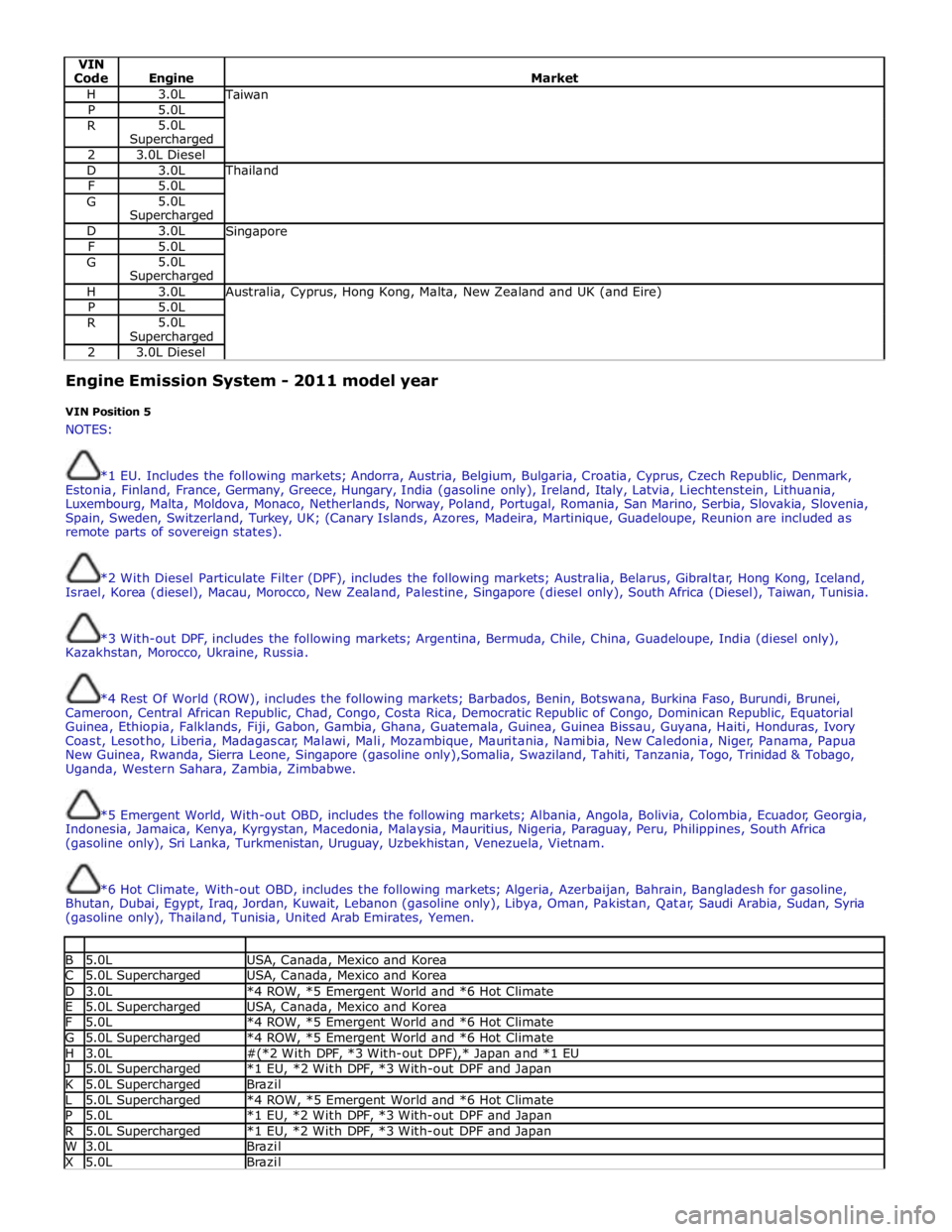
VIN
Code
Engine
Market H 3.0L
Taiwan P 5.0L R 5.0L
Supercharged 2 3.0L Diesel D 3.0L
Thailand F 5.0L G 5.0L
Supercharged D 3.0L
Singapore F 5.0L G 5.0L
Supercharged H 3.0L
Australia, Cyprus, Hong Kong, Malta, New Zealand and UK (and Eire) P 5.0L R 5.0L
Supercharged 2 3.0L Diesel Engine Emission System - 2011 model year
VIN Position 5
NOTES:
*1 EU. Includes the following markets; Andorra, Austria, Belgium, Bulgaria, Croatia, Cyprus, Czech Republic, Denmark,
Estonia, Finland, France, Germany, Greece, Hungary, India (gasoline only), Ireland, Italy, Latvia, Liechtenstein, Lithuania,
Luxembourg, Malta, Moldova, Monaco, Netherlands, Norway, Poland, Portugal, Romania, San Marino, Serbia, Slovakia, Slovenia,
Spain, Sweden, Switzerland, Turkey, UK; (Canary Islands, Azores, Madeira, Martinique, Guadeloupe, Reunion are included as
remote parts of sovereign states).
*2 With Diesel Particulate Filter (DPF), includes the following markets; Australia, Belarus, Gibraltar, Hong Kong, Iceland,
Israel, Korea (diesel), Macau, Morocco, New Zealand, Palestine, Singapore (diesel only), South Africa (Diesel), Taiwan, Tunisia.
*3 With-out DPF, includes the following markets; Argentina, Bermuda, Chile, China, Guadeloupe, India (diesel only),
Kazakhstan, Morocco, Ukraine, Russia.
*4 Rest Of World (ROW), includes the following markets; Barbados, Benin, Botswana, Burkina Faso, Burundi, Brunei,
Cameroon, Central African Republic, Chad, Congo, Costa Rica, Democratic Republic of Congo, Dominican Republic, Equatorial
Guinea, Ethiopia, Falklands, Fiji, Gabon, Gambia, Ghana, Guatemala, Guinea, Guinea Bissau, Guyana, Haiti, Honduras, Ivory
Coast, Lesotho, Liberia, Madagascar, Malawi, Mali, Mozambique, Mauritania, Namibia, New Caledonia, Niger, Panama, Papua
New Guinea, Rwanda, Sierra Leone, Singapore (gasoline only),Somalia, Swaziland, Tahiti, Tanzania, Togo, Trinidad & Tobago,
Uganda, Western Sahara, Zambia, Zimbabwe.
*5 Emergent World, With-out OBD, includes the following markets; Albania, Angola, Bolivia, Colombia, Ecuador, Georgia,
Indonesia, Jamaica, Kenya, Kyrgystan, Macedonia, Malaysia, Mauritius, Nigeria, Paraguay, Peru, Philippines, South Africa
(gasoline only), Sri Lanka, Turkmenistan, Uruguay, Uzbekhistan, Venezuela, Vietnam.
*6 Hot Climate, With-out OBD, includes the following markets; Algeria, Azerbaijan, Bahrain, Bangladesh for gasoline,
Bhutan, Dubai, Egypt, Iraq, Jordan, Kuwait, Lebanon (gasoline only), Libya, Oman, Pakistan, Qatar, Saudi Arabia, Sudan, Syria
(gasoline only), Thailand, Tunisia, United Arab Emirates, Yemen.
B 5.0L USA, Canada, Mexico and Korea C 5.0L Supercharged USA, Canada, Mexico and Korea D 3.0L *4 ROW, *5 Emergent World and *6 Hot Climate E 5.0L Supercharged USA, Canada, Mexico and Korea F 5.0L *4 ROW, *5 Emergent World and *6 Hot Climate G 5.0L Supercharged *4 ROW, *5 Emergent World and *6 Hot Climate H 3.0L #(*2 With DPF, *3 With-out DPF),* Japan and *1 EU J 5.0L Supercharged *1 EU, *2 With DPF, *3 With-out DPF and Japan K 5.0L Supercharged Brazil L 5.0L Supercharged *4 ROW, *5 Emergent World and *6 Hot Climate P 5.0L *1 EU, *2 With DPF, *3 With-out DPF and Japan R 5.0L Supercharged *1 EU, *2 With DPF, *3 With-out DPF and Japan W 3.0L Brazil X 5.0L Brazil
Page 287 of 3039
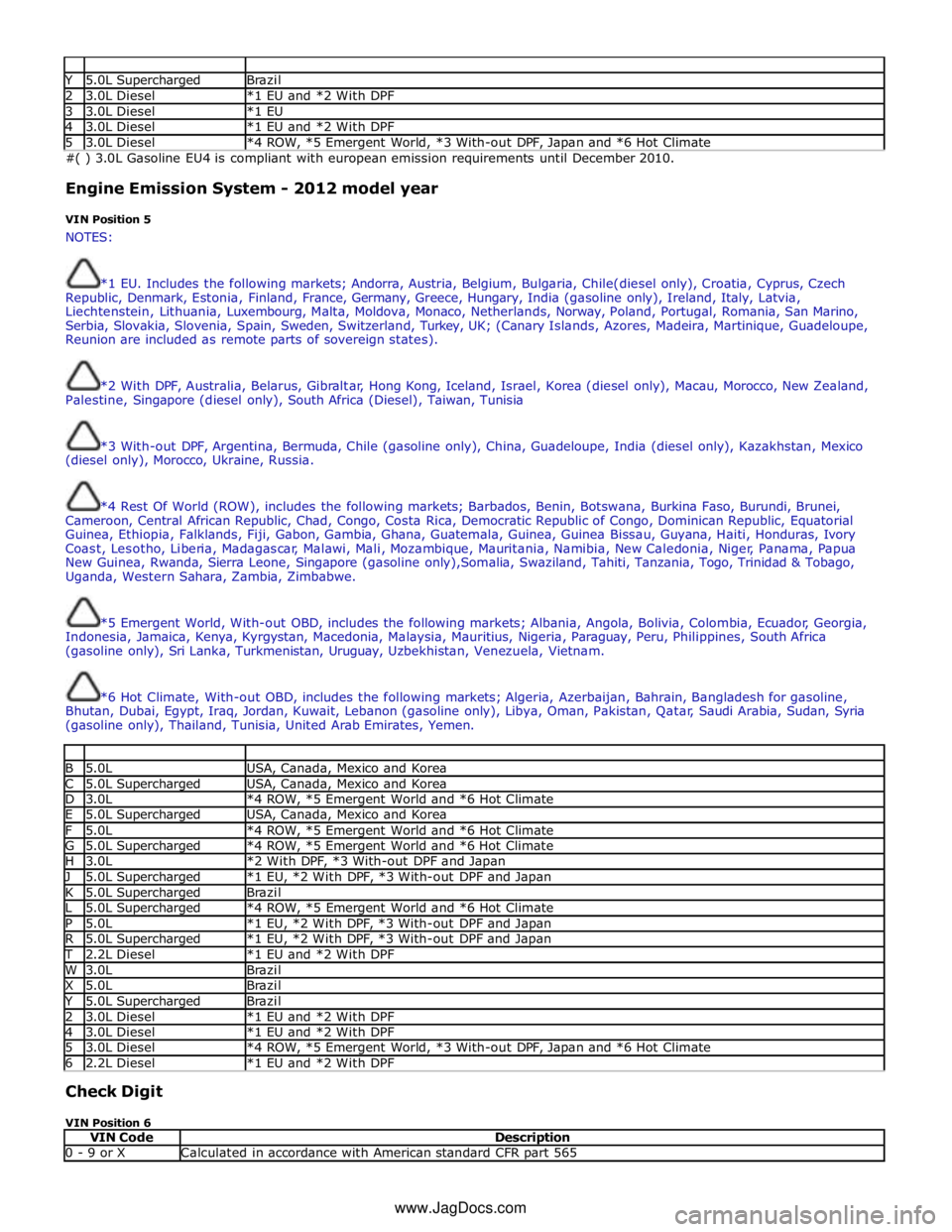
Y 5.0L Supercharged Brazil 2 3.0L Diesel *1 EU and *2 With DPF 3 3.0L Diesel *1 EU 4 3.0L Diesel *1 EU and *2 With DPF 5 3.0L Diesel *4 ROW, *5 Emergent World, *3 With-out DPF, Japan and *6 Hot Climate #( ) 3.0L Gasoline EU4 is compliant with european emission requirements until December 2010.
Engine Emission System - 2012 model year
VIN Position 5
NOTES:
*1 EU. Includes the following markets; Andorra, Austria, Belgium, Bulgaria, Chile(diesel only), Croatia, Cyprus, Czech
Republic, Denmark, Estonia, Finland, France, Germany, Greece, Hungary, India (gasoline only), Ireland, Italy, Latvia,
Liechtenstein, Lithuania, Luxembourg, Malta, Moldova, Monaco, Netherlands, Norway, Poland, Portugal, Romania, San Marino,
Serbia, Slovakia, Slovenia, Spain, Sweden, Switzerland, Turkey, UK; (Canary Islands, Azores, Madeira, Martinique, Guadeloupe,
Reunion are included as remote parts of sovereign states).
*2 With DPF, Australia, Belarus, Gibraltar, Hong Kong, Iceland, Israel, Korea (diesel only), Macau, Morocco, New Zealand,
Palestine, Singapore (diesel only), South Africa (Diesel), Taiwan, Tunisia
*3 With-out DPF, Argentina, Bermuda, Chile (gasoline only), China, Guadeloupe, India (diesel only), Kazakhstan, Mexico
(diesel only), Morocco, Ukraine, Russia.
*4 Rest Of World (ROW), includes the following markets; Barbados, Benin, Botswana, Burkina Faso, Burundi, Brunei,
Cameroon, Central African Republic, Chad, Congo, Costa Rica, Democratic Republic of Congo, Dominican Republic, Equatorial
Guinea, Ethiopia, Falklands, Fiji, Gabon, Gambia, Ghana, Guatemala, Guinea, Guinea Bissau, Guyana, Haiti, Honduras, Ivory
Coast, Lesotho, Liberia, Madagascar, Malawi, Mali, Mozambique, Mauritania, Namibia, New Caledonia, Niger, Panama, Papua
New Guinea, Rwanda, Sierra Leone, Singapore (gasoline only),Somalia, Swaziland, Tahiti, Tanzania, Togo, Trinidad & Tobago,
Uganda, Western Sahara, Zambia, Zimbabwe.
*5 Emergent World, With-out OBD, includes the following markets; Albania, Angola, Bolivia, Colombia, Ecuador, Georgia,
Indonesia, Jamaica, Kenya, Kyrgystan, Macedonia, Malaysia, Mauritius, Nigeria, Paraguay, Peru, Philippines, South Africa
(gasoline only), Sri Lanka, Turkmenistan, Uruguay, Uzbekhistan, Venezuela, Vietnam.
*6 Hot Climate, With-out OBD, includes the following markets; Algeria, Azerbaijan, Bahrain, Bangladesh for gasoline,
Bhutan, Dubai, Egypt, Iraq, Jordan, Kuwait, Lebanon (gasoline only), Libya, Oman, Pakistan, Qatar, Saudi Arabia, Sudan, Syria
(gasoline only), Thailand, Tunisia, United Arab Emirates, Yemen.
B 5.0L USA, Canada, Mexico and Korea C 5.0L Supercharged USA, Canada, Mexico and Korea D 3.0L *4 ROW, *5 Emergent World and *6 Hot Climate E 5.0L Supercharged USA, Canada, Mexico and Korea F 5.0L *4 ROW, *5 Emergent World and *6 Hot Climate G 5.0L Supercharged *4 ROW, *5 Emergent World and *6 Hot Climate H 3.0L *2 With DPF, *3 With-out DPF and Japan J 5.0L Supercharged *1 EU, *2 With DPF, *3 With-out DPF and Japan K 5.0L Supercharged Brazil L 5.0L Supercharged *4 ROW, *5 Emergent World and *6 Hot Climate P 5.0L *1 EU, *2 With DPF, *3 With-out DPF and Japan R 5.0L Supercharged *1 EU, *2 With DPF, *3 With-out DPF and Japan T 2.2L Diesel *1 EU and *2 With DPF W 3.0L Brazil X 5.0L Brazil Y 5.0L Supercharged Brazil 2 3.0L Diesel *1 EU and *2 With DPF 4 3.0L Diesel *1 EU and *2 With DPF 5 3.0L Diesel *4 ROW, *5 Emergent World, *3 With-out DPF, Japan and *6 Hot Climate 6 2.2L Diesel *1 EU and *2 With DPF Check Digit
VIN Position 6
VIN Code Description 0 - 9 or X Calculated in accordance with American standard CFR part 565 www.JagDocs.com
Page 1591 of 3039
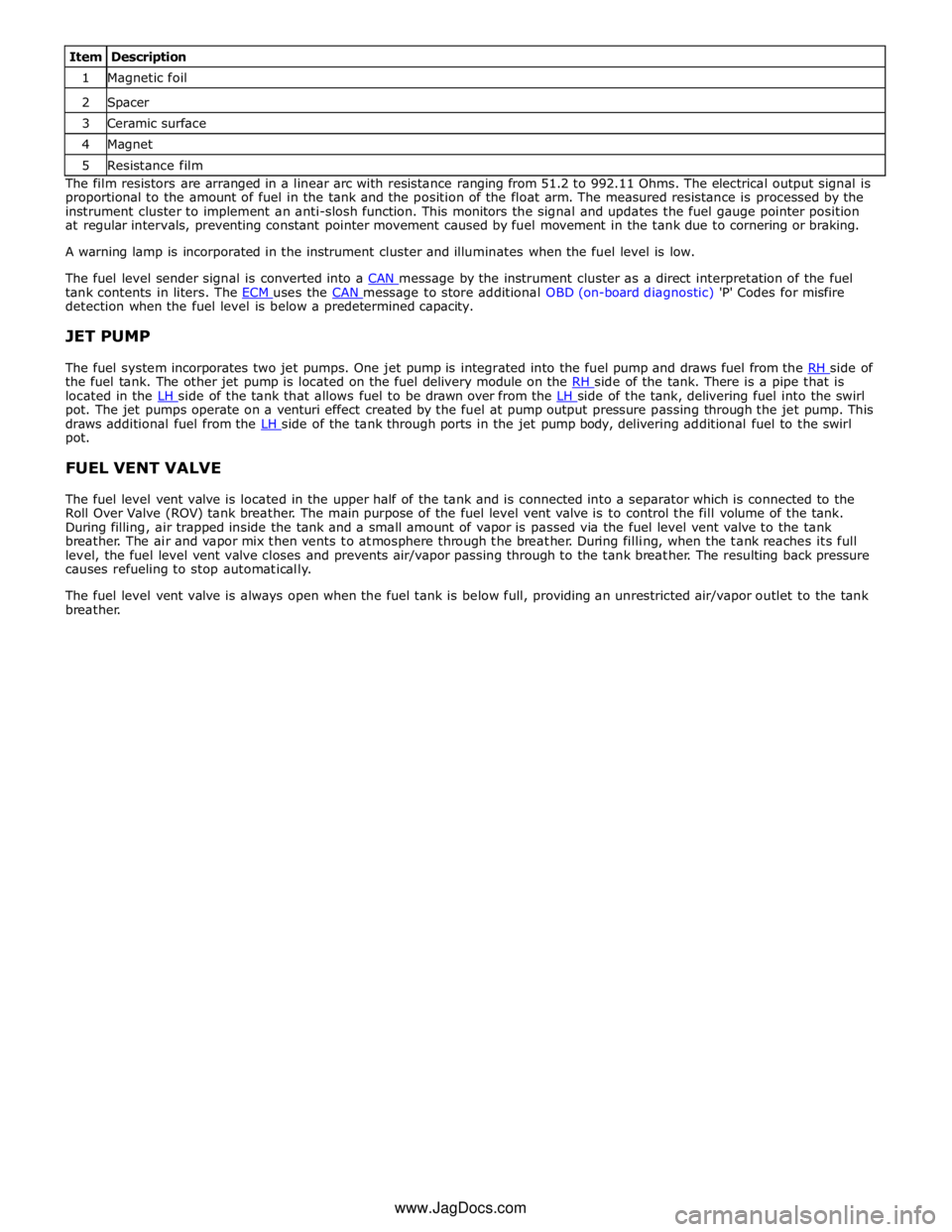
1 Magnetic foil 2 Spacer 3 Ceramic surface 4 Magnet 5 Resistance film The film resistors are arranged in a linear arc with resistance ranging from 51.2 to 992.11 Ohms. The electrical output signal is
proportional to the amount of fuel in the tank and the position of the float arm. The measured resistance is processed by the
instrument cluster to implement an anti-slosh function. This monitors the signal and updates the fuel gauge pointer position
at regular intervals, preventing constant pointer movement caused by fuel movement in the tank due to cornering or braking.
A warning lamp is incorporated in the instrument cluster and illuminates when the fuel level is low.
The fuel level sender signal is converted into a CAN message by the instrument cluster as a direct interpretation of the fuel tank contents in liters. The ECM uses the CAN message to store additional OBD (on-board diagnostic) 'P' Codes for misfire detection when the fuel level is below a predetermined capacity.
JET PUMP
The fuel system incorporates two jet pumps. One jet pump is integrated into the fuel pump and draws fuel from the RH side of the fuel tank. The other jet pump is located on the fuel delivery module on the RH side of the tank. There is a pipe that is located in the LH side of the tank that allows fuel to be drawn over from the LH side of the tank, delivering fuel into the swirl pot. The jet pumps operate on a venturi effect created by the fuel at pump output pressure passing through the jet pump. This
draws additional fuel from the LH side of the tank through ports in the jet pump body, delivering additional fuel to the swirl pot.
FUEL VENT VALVE
The fuel level vent valve is located in the upper half of the tank and is connected into a separator which is connected to the
Roll Over Valve (ROV) tank breather. The main purpose of the fuel level vent valve is to control the fill volume of the tank.
During filling, air trapped inside the tank and a small amount of vapor is passed via the fuel level vent valve to the tank
breather. The air and vapor mix then vents to atmosphere through the breather. During filling, when the tank reaches its full
level, the fuel level vent valve closes and prevents air/vapor passing through to the tank breather. The resulting back pressure
causes refueling to stop automatically.
The fuel level vent valve is always open when the fuel tank is below full, providing an unrestricted air/vapor outlet to the tank
breather.
www.JagDocs.com
Page 1786 of 3039
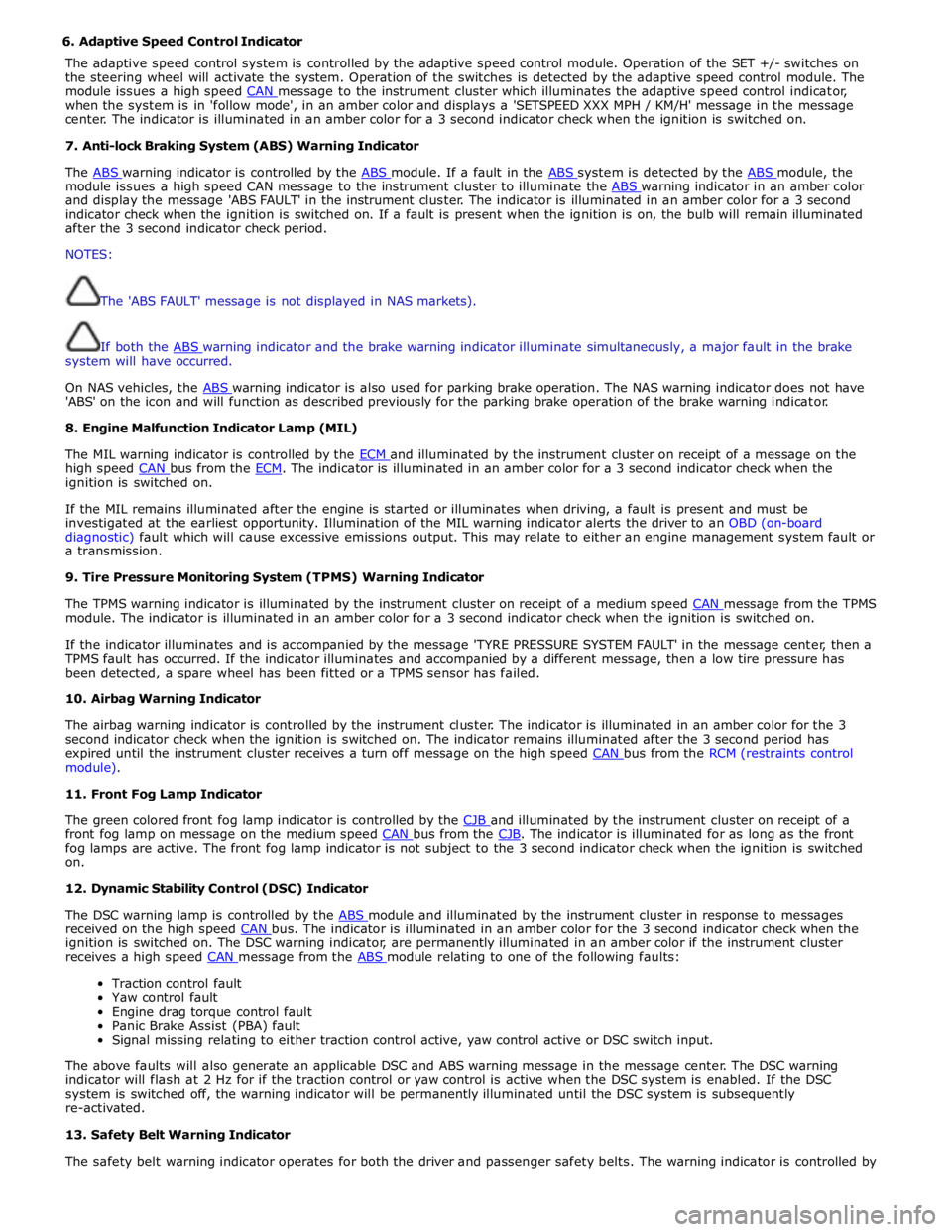
6. Adaptive Speed Control Indicator
The adaptive speed control system is controlled by the adaptive speed control module. Operation of the SET +/- switches on
the steering wheel will activate the system. Operation of the switches is detected by the adaptive speed control module. The
module issues a high speed CAN message to the instrument cluster which illuminates the adaptive speed control indicator, when the system is in 'follow mode', in an amber color and displays a 'SETSPEED XXX MPH / KM/H' message in the message
center. The indicator is illuminated in an amber color for a 3 second indicator check when the ignition is switched on.
7. Anti-lock Braking System (ABS) Warning Indicator
The ABS warning indicator is controlled by the ABS module. If a fault in the ABS system is detected by the ABS module, the module issues a high speed CAN message to the instrument cluster to illuminate the ABS warning indicator in an amber color and display the message 'ABS FAULT' in the instrument cluster. The indicator is illuminated in an amber color for a 3 second
indicator check when the ignition is switched on. If a fault is present when the ignition is on, the bulb will remain illuminated
after the 3 second indicator check period.
NOTES:
The 'ABS FAULT' message is not displayed in NAS markets).
If both the ABS warning indicator and the brake warning indicator illuminate simultaneously, a major fault in the brake system will have occurred.
On NAS vehicles, the ABS warning indicator is also used for parking brake operation. The NAS warning indicator does not have 'ABS' on the icon and will function as described previously for the parking brake operation of the brake warning indicator.
8. Engine Malfunction Indicator Lamp (MIL)
The MIL warning indicator is controlled by the ECM and illuminated by the instrument cluster on receipt of a message on the high speed CAN bus from the ECM. The indicator is illuminated in an amber color for a 3 second indicator check when the ignition is switched on.
If the MIL remains illuminated after the engine is started or illuminates when driving, a fault is present and must be
investigated at the earliest opportunity. Illumination of the MIL warning indicator alerts the driver to an OBD (on-board
diagnostic) fault which will cause excessive emissions output. This may relate to either an engine management system fault or
a transmission.
9. Tire Pressure Monitoring System (TPMS) Warning Indicator
The TPMS warning indicator is illuminated by the instrument cluster on receipt of a medium speed CAN message from the TPMS module. The indicator is illuminated in an amber color for a 3 second indicator check when the ignition is switched on.
If the indicator illuminates and is accompanied by the message 'TYRE PRESSURE SYSTEM FAULT' in the message center, then a
TPMS fault has occurred. If the indicator illuminates and accompanied by a different message, then a low tire pressure has
been detected, a spare wheel has been fitted or a TPMS sensor has failed.
10. Airbag Warning Indicator
The airbag warning indicator is controlled by the instrument cluster. The indicator is illuminated in an amber color for the 3
second indicator check when the ignition is switched on. The indicator remains illuminated after the 3 second period has
expired until the instrument cluster receives a turn off message on the high speed CAN bus from the RCM (restraints control module).
11. Front Fog Lamp Indicator
The green colored front fog lamp indicator is controlled by the CJB and illuminated by the instrument cluster on receipt of a front fog lamp on message on the medium speed CAN bus from the CJB. The indicator is illuminated for as long as the front fog lamps are active. The front fog lamp indicator is not subject to the 3 second indicator check when the ignition is switched
on.
12. Dynamic Stability Control (DSC) Indicator
The DSC warning lamp is controlled by the ABS module and illuminated by the instrument cluster in response to messages received on the high speed CAN bus. The indicator is illuminated in an amber color for the 3 second indicator check when the ignition is switched on. The DSC warning indicator, are permanently illuminated in an amber color if the instrument cluster
receives a high speed CAN message from the ABS module relating to one of the following faults:
Traction control fault
Yaw control fault
Engine drag torque control fault
Panic Brake Assist (PBA) fault
Signal missing relating to either traction control active, yaw control active or DSC switch input.
The above faults will also generate an applicable DSC and ABS warning message in the message center. The DSC warning
indicator will flash at 2 Hz for if the traction control or yaw control is active when the DSC system is enabled. If the DSC
system is switched off, the warning indicator will be permanently illuminated until the DSC system is subsequently
re-activated.
13. Safety Belt Warning Indicator
The safety belt warning indicator operates for both the driver and passenger safety belts. The warning indicator is controlled by